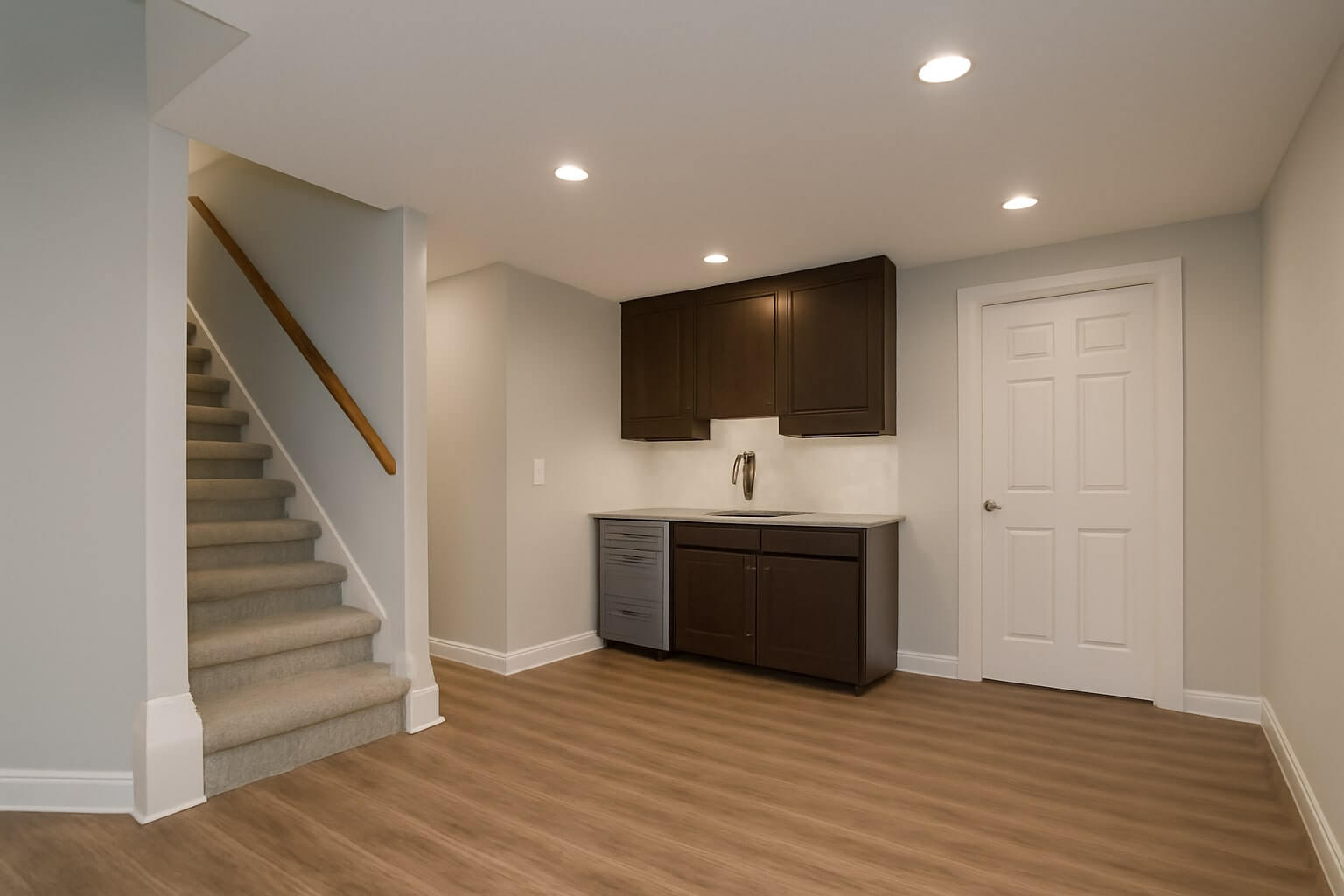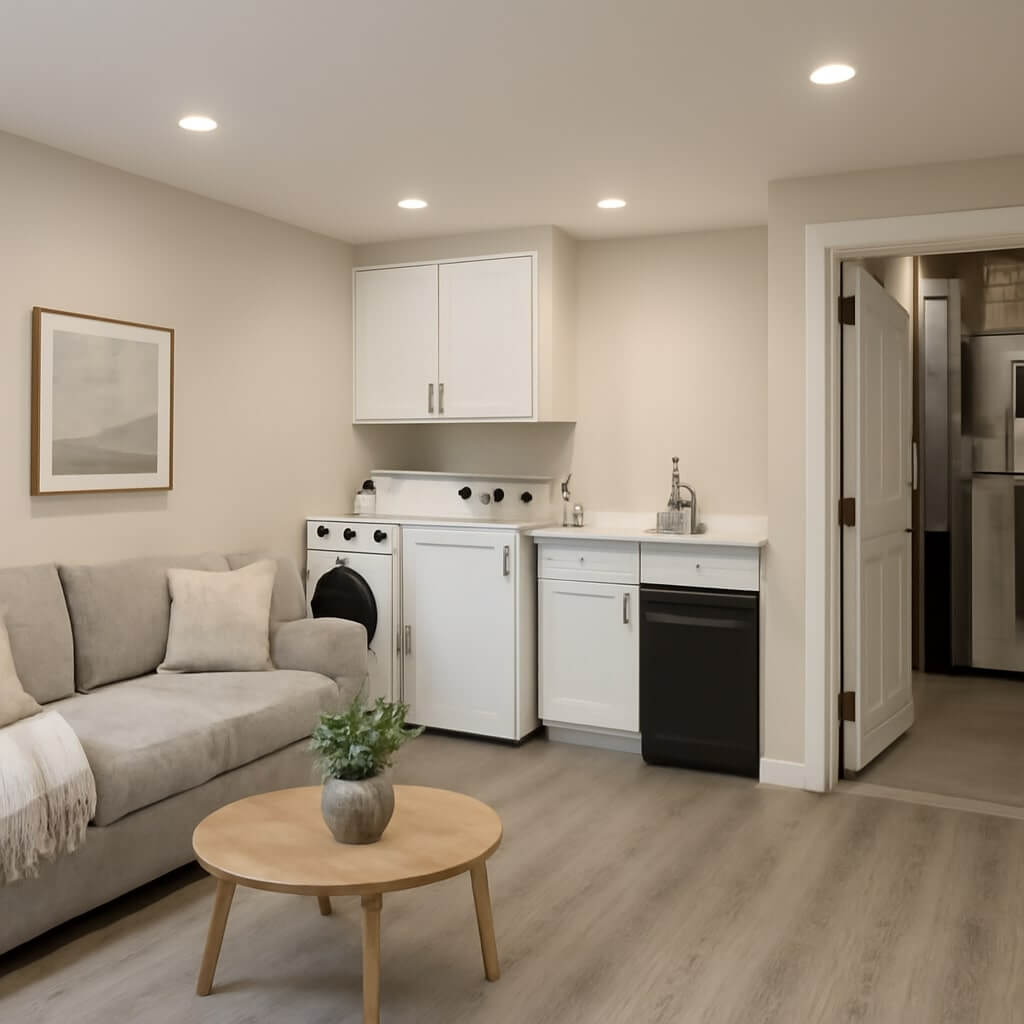When it comes to remodeling your basement, there’s a world of eco-friendly options that can enhance both comfort and sustainability. From energy-efficient lighting to sustainable flooring materials, every choice you make can minimize your environmental impact. Plus, incorporating elements like water conservation strategies and indoor air quality enhancements can transform your space into a green oasis. So, what are the best ways to achieve a stylish yet sustainable basement that meets your needs?
Key Takeaways
- Utilize energy-efficient lighting solutions, like LED bulbs and smart systems, to enhance ambiance while reducing energy costs in basements.
- Choose sustainable flooring options such as bamboo or cork for durability and eco-friendliness, contributing to a cozy environment.
- Implement water conservation strategies, including low-flow fixtures and rainwater harvesting, to minimize water usage and lower utility bills.
- Incorporate reclaimed and recycled materials for unique design elements, enhancing aesthetics while reducing waste and environmental impact.
- Enhance indoor air quality and aesthetics with living walls, utilizing potted plants and vertical gardens to create a refreshing atmosphere.
Energy-Efficient Lighting Solutions

When you’re looking to brighten up your basement while keeping energy costs low, consider energy-efficient lighting solutions that not only illuminate your space but also reduce your carbon footprint.
Smart lighting systems allow you to control brightness and schedule usage, ensuring you only use energy when needed. Pair this with LED options, which consume considerably less electricity and last longer than traditional bulbs.
These modern solutions create a warm, inviting atmosphere while saving you money. By choosing energy-efficient lighting, you’re making a sustainable choice that enhances your basement’s functionality and aesthetics without sacrificing comfort or style.
Sustainable Flooring Options
Choosing sustainable flooring options can transform your basement into an eco-friendly haven while adding character and comfort.
Bamboo flooring is a fantastic choice; it’s renewable, durable, and offers a natural aesthetic. Plus, its rapid growth means less environmental impact compared to traditional hardwoods.
Bamboo flooring is a sustainable, durable option that brings natural beauty to your space while minimizing environmental impact.
Alternatively, consider cork tiles, which aren’t only sustainable but also provide excellent insulation and sound absorption. They’re harvested from the bark of cork oak trees without harming the tree itself, making them a truly eco-friendly option.
Both materials enhance your space while promoting sustainability, creating a cozy retreat that aligns with your green living goals.
Eco-Friendly Insulation Materials

When it comes to insulating your basement, you’ve got some fantastic eco-friendly options.
Consider natural fibers like sheep’s wool or cotton for a sustainable choice, or explore recycled materials like denim insulation that not only save energy but also reduce waste.
These materials not only keep your space cozy but also contribute to a healthier planet.
Natural Fiber Insulation Options
Natural fiber insulation options offer a sustainable solution for improving your basement’s energy efficiency while minimizing environmental impact.
Consider hemp insulation, which isn’t only renewable but also boasts excellent thermal properties and moisture resistance. Its natural resistance to mold and pests makes it a smart choice for basements.
Alternatively, cotton batting can provide effective insulation, made from recycled denim and treated for fire resistance. Both materials are non-toxic and contribute to better indoor air quality.
Recycled Material Insulation Solutions
If you’re looking for additional eco-friendly insulation options, consider recycled material insulation solutions. These materials not only promote sustainable sourcing but also provide excellent thermal performance. You can reduce your carbon footprint while enhancing your basement’s energy efficiency. Check out the table below to explore some great options:
| Material | Benefits | Thermal Performance |
|---|---|---|
| Recycled Denim | Durable and moisture-resistant | High |
| Cellulose | Made from recycled paper | Excellent |
| Recycled Glass | Non-combustible | Good |
| Reclaimed Wood Fiber | Biodegradable and renewable | Moderate |
Opt for these innovative materials to transform your space sustainably!
Water Conservation Strategies

When it comes to conserving water in your basement, you’ve got some smart options at your fingertips.
Consider installing a rainwater harvesting system to collect and reuse nature’s resource, or switch to low-flow fixtures that reduce water waste without sacrificing performance.
You can also explore greywater recycling systems to repurpose water from sinks and showers, making every drop count.
Rainwater Harvesting Systems
Although many homeowners overlook their basements, incorporating rainwater harvesting systems can transform this often-neglected space into a sustainable asset.
By utilizing a rooftop catchment, you can collect rainwater that would otherwise go to waste. Install a rainwater filtration system to guarantee the water is clean and safe for use, whether it’s for irrigation or non-potable household purposes.
This innovative approach not only conserves water but also reduces your utility bills. You’ll be surprised how a few strategic changes can make your basement a hub for eco-friendly living, enhancing both your home’s value and environmental impact.
Low-Flow Fixtures
To create a more sustainable basement, consider installing low-flow fixtures, which can greatly reduce your water consumption.
Low flow toilets use considerably less water per flush compared to traditional models, saving you money on your water bill.
Additionally, water-saving showerheads can help you enjoy a revitalizing shower without wasting gallons of water.
By upgrading these fixtures, you not only contribute to water conservation but also enhance the overall efficiency of your basement.
These simple changes make a big impact on your environmental footprint while providing a practical solution for everyday water use.
Embrace these eco-friendly options today!
Greywater Recycling Systems
By incorporating greywater recycling systems into your basement, you can greatly boost your water conservation efforts. These systems collect water from sinks, showers, and washing machines, filtering it for reuse in irrigation or toilet flushing. Using effective filtration methods guarantees the water remains safe and reduces overall consumption.
| Greywater Source | Filtration Method | Possible Uses |
|---|---|---|
| Shower | Sand filter | Irrigation |
| Sink | Activated carbon filter | Toilet flushing |
| Washing machine | Mesh filter | Landscape watering |
| Laundry | UV filtration | Non-potable uses |
| Bath | Biological filter | Garden irrigation |
Using Reclaimed and Recycled Materials

When you choose to use reclaimed and recycled materials in your basement, you’re not just making an eco-friendly choice; you’re also adding unique character to your space.
Reclaimed wood can create stunning beams, flooring, or wall accents, showcasing its history while reducing waste. Pair it with recycled glass fixtures or countertops to enhance both aesthetics and sustainability.
These materials not only minimize your environmental footprint but also provide durability and timeless appeal.
Indoor Air Quality Enhancements

Although you mightn’t think about it, the air quality in your basement can greatly impact your overall health and comfort.
To improve indoor air quality, consider installing efficient ventilation systems that promote fresh air circulation. This helps reduce moisture and prevents mold growth.
Additionally, investing in high-quality air purifiers can effectively filter out dust, allergens, and pollutants. Look for models with HEPA filters to guarantee maximum efficiency.
By implementing these enhancements, you’ll create a healthier basement environment, making it a more enjoyable space for relaxation or activities.
Prioritize air quality—it’s a crucial step in green remodeling.
Biophilic Design Elements

Incorporating biophilic design elements into your basement can transform it into a vibrant, nature-inspired retreat. By adding features like living walls and maximizing natural lighting, you’ll create a soothing atmosphere that enhances well-being.
Here’s a quick look at how these elements can enrich your space:
| Element | Benefit | Implementation |
|---|---|---|
| Living Walls | Purifies air, aesthetic appeal | Use potted plants or vertical gardens |
| Natural Lighting | Boosts mood and productivity | Add windows or skylights |
| Earthy Materials | Creates warmth and comfort | Choose wood, stone, or clay |
Embrace nature and elevate your basement!
Conclusion
By embracing eco-friendly ideas for your basement remodel, you’re not just creating a stylish space but also making a positive impact on the environment. From energy-efficient lighting to sustainable flooring and water conservation strategies, every choice matters. Incorporating reclaimed materials and enhancing indoor air quality will further elevate your home’s sustainability. So, go ahead—transform your basement into a green haven that reflects your commitment to the planet while providing a comfortable retreat for you and your family.



